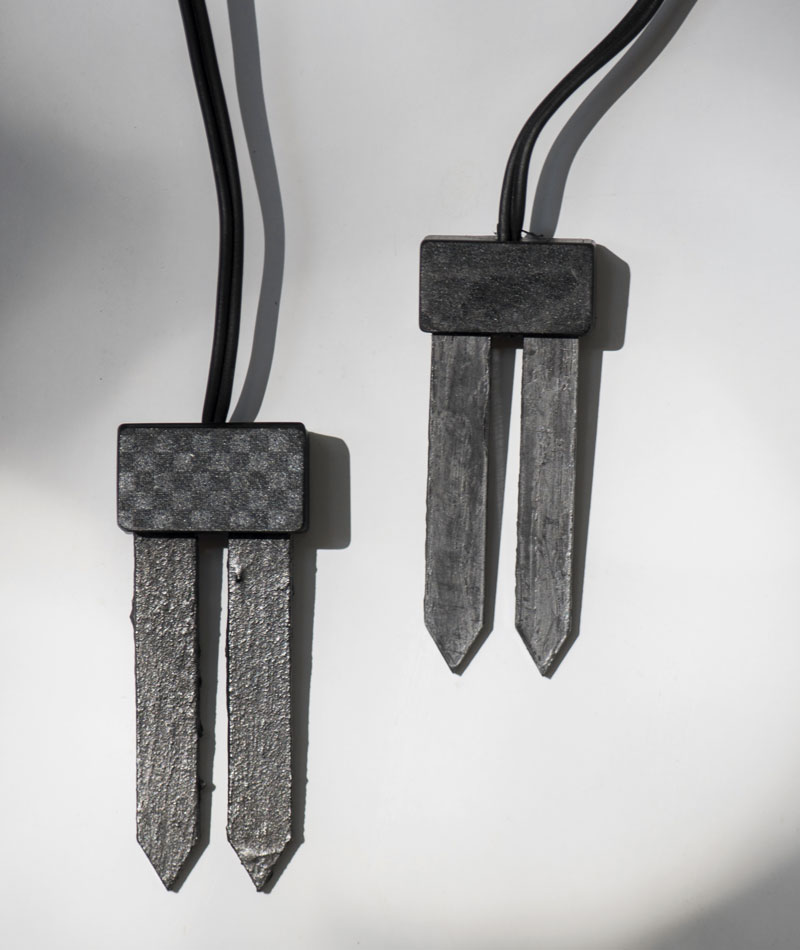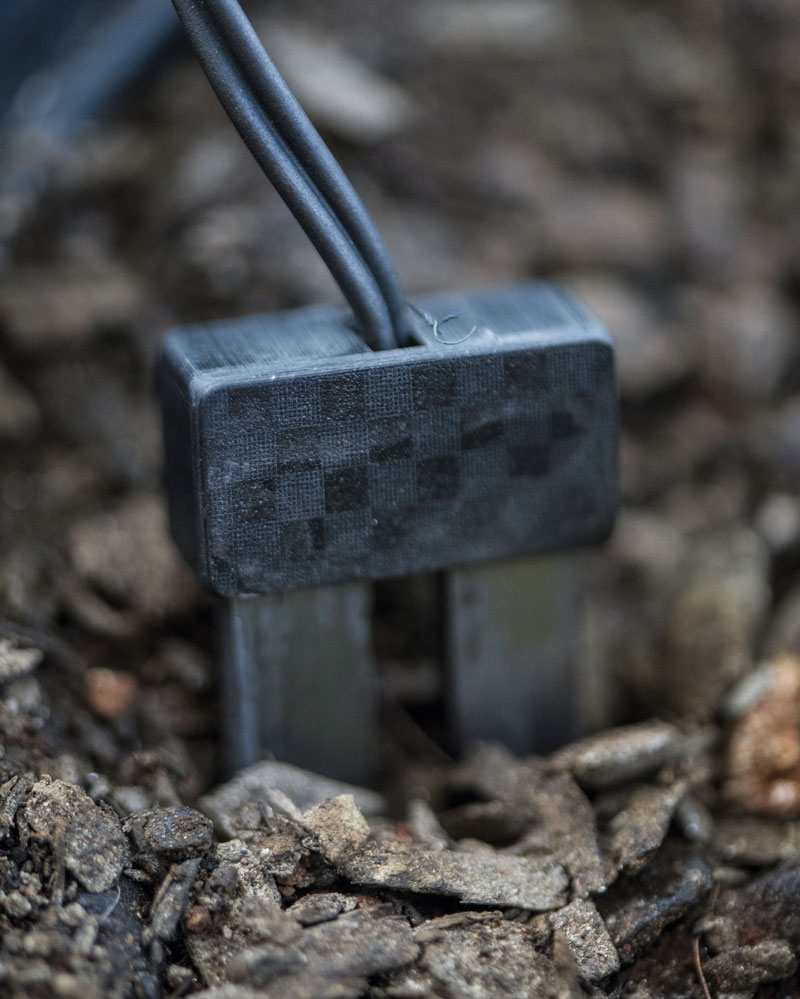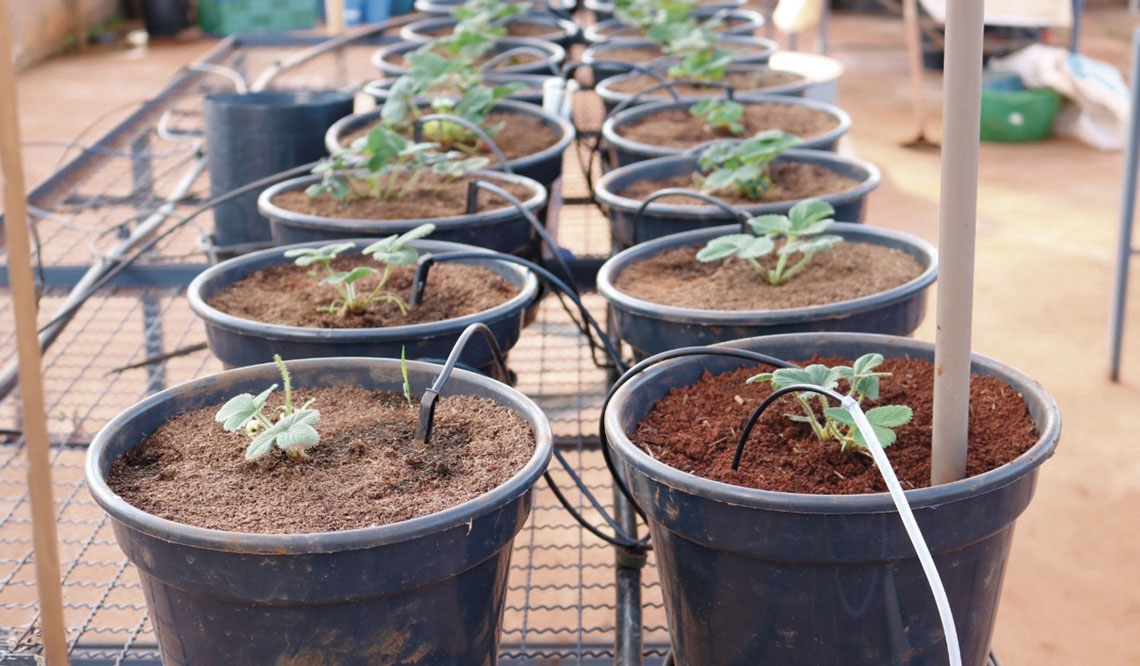Brazilian farmers have at their disposal two new models for soil moisture sensors in Brazil. One such device, created at the University of Campinas’s Institute of Biology (IB-UNICAMP) and licensed to the company Galembetech, a spin-off of the university, differs from other similar devices on the market due to one important detail: it uses a nonmetallic conductive material that is graphite-based, making it resistant to corrosion. As a result, it is more durable. For this innovation, biologist Eduardo Galembeck and engineering student Yago Sampaio Guido received the 2023 UNICAMP Inventors Award in the Licensed Intellectual Property category.
Galembetech has already produced a batch of 50 sensors. “Our plan is to first launch the product and then make it available in agricultural stores and websites.” says Galembeck. In the future, to scale up, the start-up must outsource production. According to the researcher, who is a partner at Galembetech and a professor at IB-UNICAMP, a patent application has already been submitted for the sensor.
The second sensor is the product of work carried out at the Brazilian Agricultural Research Corporation (EMBRAPA). The team working at the EMBRAPA Instrumentation unit in São Paulo is focused on devices used to measure the so-called soil matric potential, i.e. the force or tension with which the soil particles retain water. Also called tensiometers, the devices are composed of permeable ceramic material containing water inside. As the soil dries out, water tends to flow out of the sensor, generating a vacuum equivalent to the water tension in the soil. It operates cyclically: when rain or irrigation wets the soil, the sensors will absorb water and return to their initial state.
The project, supported by FAPESP, seeks to improve two models released in 2015 (see Pesquisa FAPESP issue nº 234). Physicist Carlos Manoel Pedro Vaz, responsible for developing the devices, clarifies that they have lost their sensitivity and should return to the laboratory. A new model, called the IGstat, cocreated with Tecnicer Cerâmica, located in São Carlos, is already on the market.
Sustainable water use
Sensors aimed at encouraging the rational use of water in farming tend to be increasingly employed in irrigation systems because of global warming and the more intense water scarcity scenario it portends. “We have to use the technological resources available to apply water to crops at the right time and in the right amount,” argues agronomist Rubens Duarte Coelho, a professor at the Luiz de Queiroz College of Agriculture at the University of São Paulo (ESALQ-USP). He is coauthor of the book Agricultura irrigada no Brasil: Ciência e tecnologia (Irrigated agriculture in Brazil: Science and technology; ESALQ, 2022).

Léo Ramos Chaves / Pesquisa Fapesp
UNICAMP’s sensor, with two electrodes, was licensed to the start-up GalembetechLéo Ramos Chaves / Pesquisa FapespAccording to the agronomist, in the last 15 years, there have been more consultations focused on irrigation management, which involves installing sensors to assess the status of water in the soil. There are several available models, with different operating principles. In general, they can be classified into one of three categories: those that measure the volume of water in the soil (resistive), those that are sensitive to the dielectric constant of the soil (capacitive), and those that measure the tension with which the water is retained (tensiometric).
“The most modern and reliable sensors are tensiometric and capacitive, making up 98% of the market. They don’t contain any metallic elements in contact with the ground and remain stable over many years. That’s why they are the bestsellers,” says Coelho.
UNICAMP’s sensor is resistive. It focuses on the soil’s electrical resistance, which varies according to the amount of water present. Galembeck explains that the device measures the water volume based on the variation in electrical resistance between two electrodes inserted into the ground. “The greater the amount of water, the lower the electrical resistance measured,” he says.
It works like other resistive sensor models on the market, but its use of graphite as a conductive material, in place of metal components, makes it a more durable and economic option. “Resistive sensors cost upwards of R$15, but can reach up to R$1,000, depending on the material used, the durability, and if they are domestically manufactured or imported. Our cost, at the point of sale, is approximately R$25. This is in the lower price range, but the sensors are as durable as the more expensive ones,” says Galembeck.
According to the researcher, some metal sensors begin to fail after just a few months of use. UNICAMP’s device has shown no signs of damage after 18 months of continuous use in field tests. The question of durability was what prompted the study, which began in 2017. “I was working on another project, related to microscopic life, when I had trouble setting up an experiment in a terrarium,” recalls Galembeck. “It was monitored by several sensors, including a moisture sensor, which failed before conclusion of the experiment. I contacted the team from another project I worked on, which was researching a new graphite-based material, and we decided to use it to solve the issue of premature wear within the sensor.”
Galembetech and science intern Yago Guido participated in the development process, with support from FAPESP’s Innovative Research in Small Business (PIPE) program. “The availability of this product on the market closes a cycle that began with basic research as part of a science teaching project and resulted in a patent and technological innovation,” Galembeck stated.
Galembetech is preparing an advertising campaign to win over consumers. This may not be a very easy task. According to Vaz, from EMBRAPA, use of these sensors for irrigation management and control is not an established practice in the industry. “For most farmers, irrigation schedules are determined by the price of electricity. The soil’s and plants’ needs are often overlooked, and water ends up being wasted. He hopes that the inclusion of more domestic products on the market, in addition to technical assistance for farmers, will help change this scenario.
Agricultural engineer Everardo Mantovani, creator of the Group for Studies and Solutions in Irrigated Agriculture at the Federal University of Viçosa (UFV), in Minas Gerais, and professor emeritus at the institution, believes that technical knowledge is essential for this technology to be successful. “If not properly used, the sensors become economically impractical,” he says.
The size of the property also determines how the device is used. In larger agricultural areas, explains Mantovani, there may be differences in soil characteristics depending on the location, which would require several sensors to be installed for a more accurate assessment—increasing the cost of implementing the technology. “The sensors work really well on smaller farms and those with higher added value, such as vegetable crops,” he notes.
Projects
1. Manufacturing and applications of multifunctional materials (nº 22/01668-4); Grant Mechanism Innovative Research in Small Businesses (PIPE); Principal Investigator Fernando Galembeck (GG & FG Consultores); Investment R$752,600.00.
2. Conductive paints, adhesives, and coatings based on exfoliated graphite, applied to the construction of electrical components and circuits ( nº 18/00834-2); Grant Mechanism Innovative Research in Small Businesses (PIPE); Principal Investigator Fernando Galembeck (GG & FG Consultores); Investment R$494,619.08.
3. INCT 2014: In Functional Complex Materials – Inomat (nº 14/50906-9); Grant Mechanism Regular Research Grant; Principal Investigator Fernando Galembeck (CAMPINAS); Investment R$3,613,721.29.
4. Development and evaluation of new sensor devices for measuring water matrix potential in soil (nº 20/16179-3); Grant Mechanism Regular Research Grant; Principal Investigator Carlos Manoel Pedro Vaz (EMBRAPA); Investment R$178,547.61.
Book
PAOLINELLI, Alysson et al. (org). Agricultura irrigada no Brasil: Ciência e tecnologia (recurso eletrônico). Piracicaba: Esalq/USP; Viçosa: Abid, 2022.

